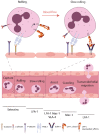Selectin-Mediated Signaling-Shedding Light on the Regulation of Integrin Activity in Neutrophils
- PMID: 35455989
- PMCID: PMC9025114
- DOI: 10.3390/cells11081310
Selectin-Mediated Signaling-Shedding Light on the Regulation of Integrin Activity in Neutrophils
Abstract
As a consequence of tissue injury or infection, neutrophils are recruited in a stepwise recruitment process from the bloodstream into the surrounding tissue. Selectins are a family of adhesion molecules comprised of L-, E-, and P-selectin. Differences in expression patterns, protein structure, and ligand binding characteristics mediate distinct functions of each selectin. Interactions of selectins and their counter-receptors mediate the first contact of neutrophils with the endothelium, as well as subsequent neutrophil rolling along the endothelial surface. For efficient neutrophil recruitment, activation of β2-integrins on the cell surface is essential. Integrin activation can be elicited via selectin- as well as chemokine-mediated inside-out signaling resulting in integrin conformational changes and clustering. Dysregulation of selectin-induced integrin activation on neutrophils is involved in the development of severe pathological disease conditions including leukocyte adhesion deficiency (LAD) syndromes in humans. Here, we review molecular mechanisms involved in selectin-mediated signaling pathways in neutrophils and their impact on integrin activation, neutrophil recruitment, and inflammatory diseases.
Keywords: PSGL-1; integrin; leukocyte recruitment; neutrophil; selectin; shedding; signaling.
Conflict of interest statement
The authors declare no conflict of interest.
Figures



Similar articles
-
Shear-dependent capping of L-selectin and P-selectin glycoprotein ligand 1 by E-selectin signals activation of high-avidity beta2-integrin on neutrophils.J Immunol. 2004 Jun 15;172(12):7780-90. doi: 10.4049/jimmunol.172.12.7780. J Immunol. 2004. PMID: 15187162
-
The effect of isoflurane on neutrophil selectin and beta(2)-integrin activation in vitro.Anesth Analg. 2002 Sep;95(3):583-7, table of contents. doi: 10.1097/00000539-200209000-00017. Anesth Analg. 2002. PMID: 12198042
-
Selectins and chemokines use shared and distinct signals to activate β2 integrins in neutrophils.Blood Adv. 2018 Apr 10;2(7):731-744. doi: 10.1182/bloodadvances.2017015602. Blood Adv. 2018. PMID: 29592875 Free PMC article.
-
Targeting Neutrophil Adhesive Events to Address Vaso-Occlusive Crisis in Sickle Cell Patients.Front Immunol. 2021 Apr 28;12:663886. doi: 10.3389/fimmu.2021.663886. eCollection 2021. Front Immunol. 2021. PMID: 33995392 Free PMC article. Review.
-
Selectins: initiators of leucocyte adhesion and signalling at the vascular wall.Cardiovasc Res. 2015 Aug 1;107(3):331-9. doi: 10.1093/cvr/cvv154. Epub 2015 May 20. Cardiovasc Res. 2015. PMID: 25994174 Free PMC article. Review.
Cited by
-
Effect of dexmedetomidine on ncRNA and mRNA profiles of cerebral ischemia-reperfusion injury in transient middle cerebral artery occlusion rats model.Front Pharmacol. 2024 Aug 7;15:1437445. doi: 10.3389/fphar.2024.1437445. eCollection 2024. Front Pharmacol. 2024. PMID: 39170713 Free PMC article.
-
Neutrophil Granulopoiesis Optimized Through Ex Vivo Expansion of Hematopoietic Progenitors in Engineered 3D Gelatin Methacrylate Hydrogels.Adv Healthc Mater. 2024 Jun;13(14):e2301966. doi: 10.1002/adhm.202301966. Epub 2024 Feb 25. Adv Healthc Mater. 2024. PMID: 38345178 Free PMC article.
-
Innate Immune Mechanisms in Normal and Adverse Pregnancy.Adv Exp Med Biol. 2025;1476:339-379. doi: 10.1007/978-3-031-85340-1_14. Adv Exp Med Biol. 2025. PMID: 40622550 Review.
-
β2-Integrin Adhesive Bond Tension under Shear Stress Modulates Cytosolic Calcium Flux and Neutrophil Inflammatory Response.Cells. 2022 Sep 9;11(18):2822. doi: 10.3390/cells11182822. Cells. 2022. PMID: 36139397 Free PMC article.
-
Endothelial Cell Dysfunction Due to Molecules Secreted by Macrophages in Sepsis.Biomolecules. 2024 Aug 9;14(8):980. doi: 10.3390/biom14080980. Biomolecules. 2024. PMID: 39199368 Free PMC article. Review.
References
Publication types
MeSH terms
Substances
LinkOut - more resources
Full Text Sources
Research Materials

